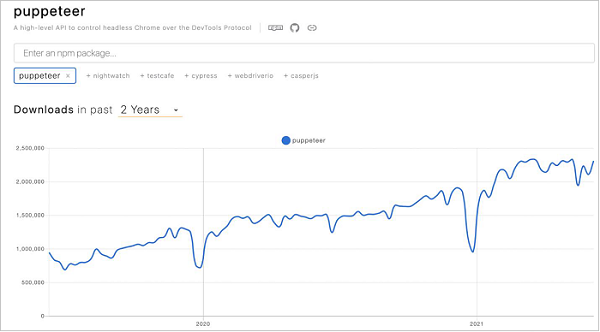
- Puppeteer - Home
- Puppeteer - Introduction
- Puppeteer - Element Handling
- Puppeteer - Usage of Google
- Puppeteer - NodeJS Installation
- Puppeteer VS Code Configuration
- Puppeteer - Installation
- Puppeteer - Basic Test
- Puppeteer - Non Headless Execution
- Comparison Between Puppeteer & Selenium
- Comparison Between Puppeteer & Protractor
- Comparison Between Puppeteer & Cypress
- Puppeteer - Browser Operations
- Puppeteer - Handling Tabs
- Puppeteer - Basic Commands
- Puppeteer - Firefox
- Puppeteer - Chrome
- Puppeteer - Handling Confirm Alerts
- Puppeteer - Handling Drop-downs
- Puppeteer - Locators
- Puppeteer - Xpath Functions
- Puppeteer - Xpath Attributes
- Puppeteer - Xpath Grouping
- Puppeteer - Absolute Xpath
- Puppeteer - Relative Xpath
- Puppeteer - Xpath Axes
- Puppeteer - Type Selector
- Name Selector & Class Name Selector
- Puppeteer - Id Selector
- Puppeteer - Attribute Selector
- Puppeteer - Handling Links/Button
- Handling Edit Boxes & Checkboxes
- Puppeteer - Handling Frames
- Puppeteer - Keyboard Simulation
- Puppeteer - Getting Element Text
- Puppeteer - Getting Element Attribute
- Puppeteer - Device Emulation
- Puppeteer - Disable JavaScript
- Puppeteer - Synchronization
- Puppeteer - Capture Screenshot
- Puppeteer Useful Resources
- Puppeteer - Quick Guide
- Puppeteer - Useful Resources
- Puppeteer - Discussion
Puppeteer - Introduction
Puppeteer is used for automation and streamlining of the frontend development and testing respectively. It was introduced by Google. Puppeteer is based on the Node.js library and is open-source.
Puppeteer contains APIs to interact and manage Chrome browser in headless mode or Chromium (following the protocols in DevTools). However, it can also be used for non-headless execution on browsers like Chrome/Chromium/Edge/Firefox.
Puppeteer can be used for the automating majority of UI testing, keyboards, mouse movements, and so on. It can be used to test applications developed in Angular and Angularjs. The actions like web page crawling and scraping can be performed with Puppeteer.
Puppeteer is not considered as an automation tool like Selenium, Cypress, Protractor, and so on. It is mostly used to manage the internal features of the Chromium browser. We can open DevTools in the Chrome browser, by pressing F12 or Command+Option+C(in MacOS).

Puppeteer is like a development tool as it is capable of performing a majority of tasks performed by a developer like handling requests and responses, locating elements, network traffic and performance, and so on.
If we follow the npm trends for Puppeteer download for the last few years, we shall observe an upward trend towards the use of Puppeteer (available from the below link) −

Puppeteer Architecture
Puppeteer utilises the Node library that gives a top-class API for managing Chromium or Chrome browsers. This is done by following the protocols of DevTools.
Puppeteer has the below hierarchy −
Browser(with/without headless mode) − The browser performs the actions to be executed on the browser engine.
Chromium Development Project or CDP − The Chromium is the real place where all the operations are executed. The browsers - Microsoft Edge and Chrome utilise Chromium as browser engine.
Puppeteer − This is actually a package based on the node module.
Automation test code − This is also known as the Nodejs level. Here, the actual automation code is developed by the end-user using JavaScript.